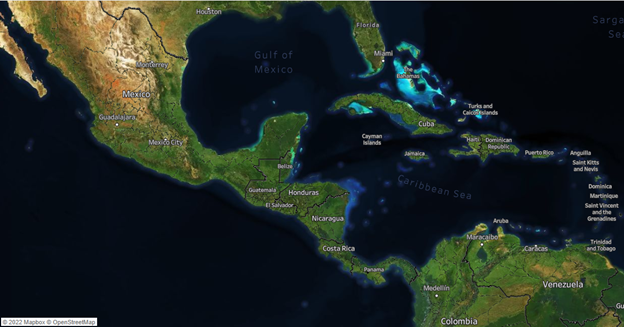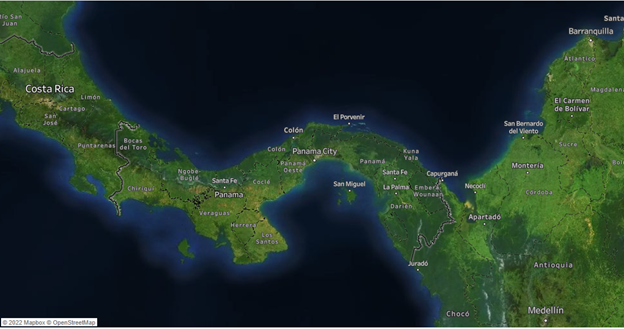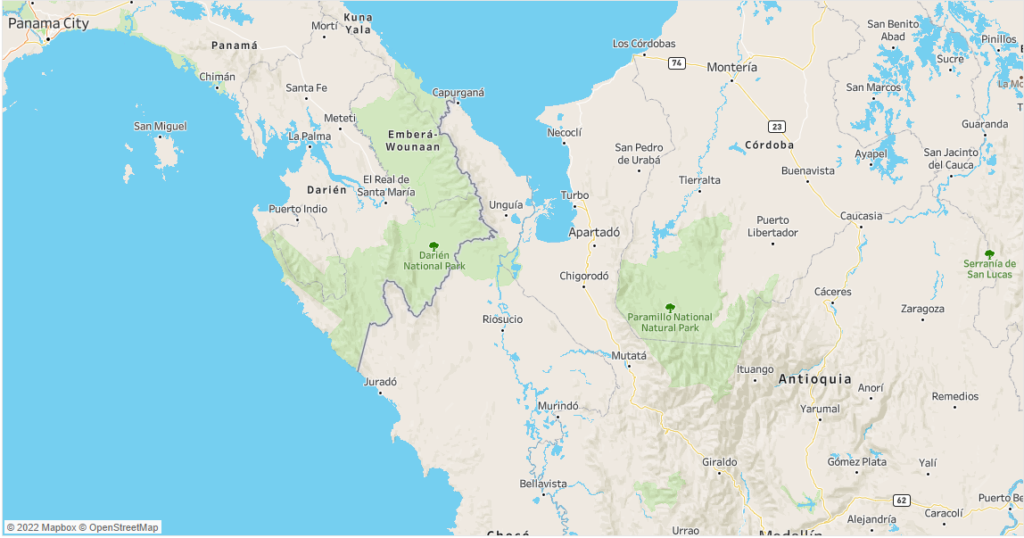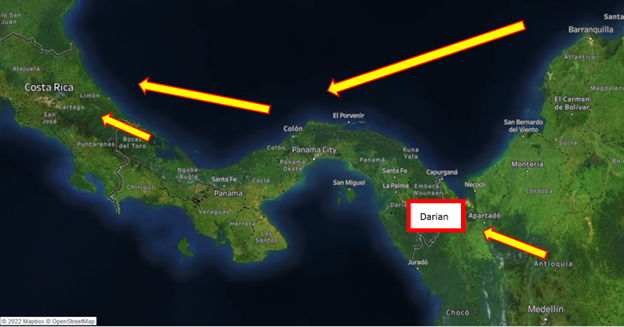
Central America has long been a transit point for cocaine from South America to North America but the situation in the region is changing rapidly. Drugs have traditionally moved from Colombia and Peru through the Darian Rainforest toward the US. The growing number of tourists in the region has caused drug traffickers to ship drugs to Central America as tourists have created a new source of revenue.
Places like the Yucatan Peninsula, Nicaragua, and Costa Rica have become destinations for drugs as the number of tourists grows. Even Panama is experiencing a boom in tourism as people come to enjoy its gorgeous mountains, beaches, and Panamanians.
Drugs remain a staple part of the illicit economy in the Americas but criminals are moving beyond drugs to diversify their income. The Panama Papers have highlighted one of Central America’s most opaque economies and Panama has done a tremendous job in transforming its banking industry away from corruption and cartels but still needs time before it can shake the corruption and cartels that have invested in the country. Panama’s opaque business practices include being a distribution point for drugs, becoming an investment haven for tax cheats and drug cartels, and even a magnet for skirting shipping regulations.

Panama Papers
Panama has positioned itself to become one of the best places to invest money in Latin America due to its extensive banking industry, its geographic location, and its regulations. The country uses the United States dollar in place of its currency, can leverage the Panama Canal to gain influence with major importers and exporters around the world, has excellent regulations on investments that allow foreigners to own 100% of a business versus other countries that require a local citizen to own 51% of the company, and has become a haven for Western retires looking to maximize their social security checks.
While Panama has become a great place to invest money, it has also become a great place for drug cartels and corrupt officials to hide money. Panama City is nicknamed “Little Miami” because the impressive skyline boasts massive skyscrapers, glamorous residential buildings, and numerous banks packed into the financial center like sardines. Just like Miami in the US, many of the banks and buildings in the city were built with drug money. The skyline in Panama City is the most impressive in all of Latin America and begs the question of where the investment money came from to fund these buildings.
The Panama Papers released an unprecedented number of documents on several high-profile individuals from around the world that were hiding money in the country. President Zelenskiy of the Ukraine owned a stake in an offshore company, the Clintons had several connections to staffers and donors that were disclosed in the Panama Papers. Even President Trump invested money into Panama City at one point but was not named in the Panama Papers. It is important to note that the Clintons, Trumps, and Zelenskiy were not accused of any wrongdoing or corruption.
In fact, very few successful prosecutions arose from the release of documents but it did result in highlighting corruption (both legal and illegal) around the world. Banks in the country have tightened regulations in the country since the release of the Panama Papers as the countries tried to mitigate the fallout of the corruption scandal. Now it is almost impossible to open up a bank account, even with legal funds. Depositors have to show documentation detailing where the money came from and how they obtained those funds. The steps Panama is taking will go a long way in reforming the country and ending corruption around the world. These new regulations are a welcome effort from industry experts around the banking industry but have done little to mitigate the investment the cartel has already made in the country.
These offshore accounts and glamorous buildings allowed individuals to hide money in Panama’s secretive banks and real-estate industry which powered the economy in Panama. This money could have been from legitimate sources as retires have flocked to the country but the Panama Papers highlight the possibility of more sinister sources.
Cartel members from around the Americas have invested heavily into the country’s banking industry and real-estate sectors and until these funds are rooted out, Panama will always be a haven for this kind of investment.
Drugs
Panama’s banking sector is not the only illicit part of the economy. It has also become a distribution point for drugs from South America to the rest of North America and Central America. Panama has always been a transit point for drugs as the country has deep connections with the US. The US dollar makes it even easier for drug traffickers to sell drugs as they move American dollars south from the US.

The preferred method of transportation for drugs used to be through the Darian Rainforest that borders the Colombian and Panamanian border. This border is separated by dense rainforest, harsh terrain, dangerous animals, and very little food or clean water. During the rainy season, floods create perilous landslides and muddy terrain that blunts the ability of hikers and traffickers to cross the border. Also, there are no roads that connect the two countries and very few members of indigenous tribes exist in the area.
These mountains and valleys are natural barriers to prevent the remnants of the FARC or the Urbanos from easily hiking across the border, especially with heavy loads of drugs. If that were not enough, special permits are needed to enter the region on the Panamanian side which makes drug trafficking even more difficult to transverse the 5 checkpoints on the road from the edge of the rainforest to Panama City as they struggle to blend in with the local population.

Instead, local drug traffickers have opted for an easier solution. It is easier for drug traffickers to ship drugs from Colombian coastal cities like Barranquilla or Cartagena by fishing or speed boats. Traffickers ship these drugs to underinvested ports that have corruptible officials in Panama or Costa Rica where they can easily bypass any security measures. These underinvested ports allow traffickers to import drugs for local consumption as patrol boats are already stretched thin. Traffickers wait for spotters to identify when patrol boats leave the area before they ship drugs along these coasts.
Once the drugs have passed through these ports, they are easily passed through land boundaries. The border between Panama and Costa Rica has an optional border check between the Bocas region of Panama and Limon of Costa Rica as border guards wave by tourists and locals without even the need for a passport stamp.
It is easy for traffickers to identify weak ports with underinvestment and poor populations in Central America. Some of these ports include Colon in Panama and Limon in Costa Rica where underinvestment has caused buildings to degrade and public parks to be neglected. The drug money that comes from these traffickers is a welcome respite from the crumbling buildings and lack of tourists.
The border between Nicaragua and Costa Rica has dense forests that afford drug traffickers anonymity. This is assuming that cartels are not growing coca plants in Honduras or Guatemala or that government officials are not importing drugs to move them north.
For its part, Panama does have checkpoints throughout the country, works with American law enforcement, and has reformed its banking sector to prevent crime and corruption.
These routes allow local affiliates of drug traffickers to feed the demand of an ever-growing number of tourists that visit Nicaragua, Costa Rica, and Panama each year. These tourists represent a major revenue source for local dealers and a turning point for drug trafficking similar to what is happening in Cancun. And with this money, violence is sure to follow.
Traditionally, drug traffickers move drugs to the US but they have recently changed their operating model. The number of pre-pandemic tourists to Costa Rica was just over 3 million tourists, which is a gain of over 50% since 2010. Panama recorded nearly 2.5 million tourists in 2019 before the pandemic, and Nicaragua recorded just over 1.4 million tourists which is down from nearly 2 million tourists in 2017. This is not a terrible number of tourists for Nicaragua as Ortega continues to crackdown on dissidents and imposes his rule on the country.
These nearly 7 million tourists represent a new opportunity for drug cartels and their local affiliates to make real money. These numbers are dwarfed by Mexico City’s 11.3 million visitors and the Yucatan Peninsula’s 8.6 million visitors in 2019 but Central America represents vast untapped potential for revenue as the number of tourists continues to grow. These tourists continue to buy drugs from local affiliates of drug cartels and have sparked violence in many parts of Central America.
Solution

One solution to the drug trafficking epidemic in Central America is to place two carrier groups on either side of Panama. America currently fields 11 carrier groups consisting of submarines, destroyers, frigates, and other ships designed to protect aircraft carriers. These ships and the soldiers that operate these vessels are an untapped potential for counter-drug operations on the water.
Currently, there are even American destroyers deployed to Panama to protect the canal while war rages in Europe. These destroyers are not conducting counter-drug operations but if they were, they could be searching cargo vessels in transit bound for Mexico and the US.
These carrier groups could be searching cargo containers, fishing boats, or intercepting planes carrying drugs. Narco-states like Venezuela would have to find other avenues to ship cocaine to the rest of the Americas. This would at least push running drugs underground which would at least make it more expensive for cartels to operate and at best it could blunt the drugs moving north and money moving south.

Flags of Convenience
Panama is far more than just a transit point between Central and South America or a haven for illicit money. The country is also the world’s largest operator of shipping vessels and is placed in a critical position for ships to traverse the Panama Canal. There are nearly 10,000 cargo vessels on the water that fly the Panamanian flag. This tiny Central American nation boasts an impressive number of ships considering that China has less than half the number of ships on the water and the US has nowhere near that number of vessels.
Panama has an open registry system where companies and individuals can own vessels in one country but fly a Panamanian flag. The open registry system brings in millions of dollars in fees, services, and taxes for the Central American state and can easily be completed online.
Flags of convenience allow owners to bypass safety inspections or avoid strict maritime regulations imposed by most countries. Having these flags also allows shippers to mask the true owners of the ship which can aid in corruption probes, pay laborers cheaper wages, and avoid income tax.
Panama has cracked down on safety violations which have allowed it to move up from the black list to the white list of the Paris Memorandum of Understanding but still boasts the most safety violations on the water. This is explained by the fact that Panama has the highest number of ships on the water and dwarfs the country with the second-largest number of flags on the water.
In the past, the ITF has charged Panama with turning a blind eye to safety and regulations but it claims that Panama is still better than some convenience flag countries. The organization has said that Panama has improved its safety regulations but there is still room for improvement.
Panama’s income also includes throngs of ships that pay to pass through the Panama Canal, money from hordes of Western tourists, numerous Western retires, agriculture exports, and their medical industry is exemplary. This all means that Panama has a diverse economy for such a small nation. The Panamanian people are happy and prospering and will continue to do so even if they root out corruption or investment from drug traffickers.
The small Central American country has improved its banking sector, has the best investment environment in Latin America, and continues to cooperate with American law enforcement to root out drug cartels in the country. This is not to mention the picturesque landscapes and serene beaches that attract tourists to the country every year. The country still has a long way to go before it rids itself of crime and corruption but it is on its way.
